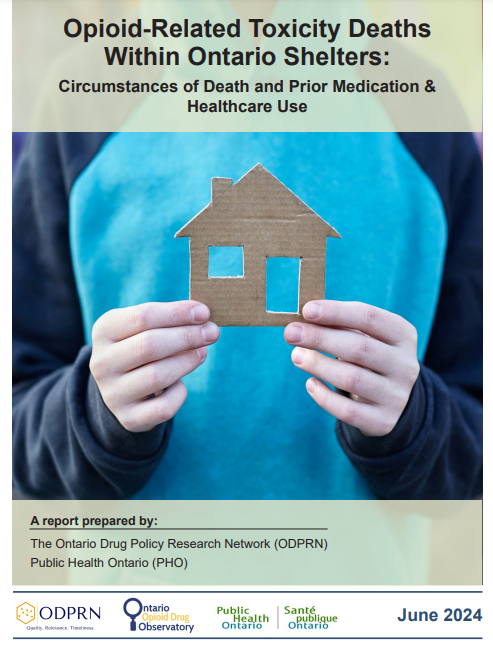Opioid-Related Toxicity Deaths Within Ontario Shelters: Circumstances of Death and Prior Medication & Healthcare Use
by: The Ontario Drug Policy Research Network (ODPRN) Public Health Ontario (PHO)
Ontario is experiencing an ongoing opioid-related toxicity crisis, with 2,534 opioid-related toxicity deaths reported in the province in 2022, representing a 63% increase from 2019.1 Shelters provide short-term accommodation for individuals or families experiencing homelessness, with 7,767 emergency shelter beds reported in Ontario 2022.2 As evidence has suggested, people experiencing homelessness are disproportionately impacted by the current drug toxicity crisis.3 Understanding the prevalence of opioid-related harms occurring within shelters, how these have changed over time, and what interventions can be introduced to support the safety of people who use drugs who access these services is imperative. This is particularly important as recent data has demonstrated that the COVID-19 pandemic has led to rising opioid toxicity deaths within shelter and supportive housing settings in Ontario, with the number of deaths more than doubling (from 20 to 46 deaths) in the first 9 months of the pandemic.4 This trend has also been reported specifically in Toronto shelter settings, where opioid-related mortality more than tripled from 17 deaths in 2019 to 57 deaths in 2022,5 causing opioid toxicities to be identified as the presumed leading cause of death in shelter settings in Toronto.6 The observed increases in opioid-related toxicity deaths in shelter settings are likely attributable to pandemic-related factors that impacted the population as a whole (e.g., an increasingly toxic unregulated drug supply, increased social isolation and using drugs alone, and pandemic-related disruptions to harm reduction and treatment services) as well as specific changes that may have occurred within shelter settings.7 Specifically, COVID-19-related disruptions had far-reaching impacts on shelters, including the displacement of residents due to physical distancing measures which may have led to accessing an unfamiliar and potentially more dangerous drug supply, decreased staff support, potential changes in overdose response, and reduced harm reduction services for shelter residents, all of which likely exacerbated opioid-related harms in this setting. Importantly, opioid use and related harms among people accessing Ontario’s. shelter system are situated within the complex interplay of several factors including social-economic and housing instability, complex health needs, trauma, mental health, stigma, and various barriers to harm-reduction and treatment.8-11 Within the context of increasing calls to address the growing opioid toxicity crisis within Ontario shelters, including improving access to harm reduction services,12 there is an urgent need to better understand the circumstances surrounding opioid-related toxicity deaths in shelters to help improve evidence-based responses. Therefore, the objective of this report is to use linked coronial records and health administrative data capturing opioid-related toxicity deaths in shelters and health service use across Ontario to better understand the demographic characteristics, circumstances surrounding death, and types of healthcare encounters preceding opioid-related toxicity deaths within Ontario shelters. The goal of this work is to help support an evidence-informed expansion of services within the shelter system that will help to prevent avoidable deaths from substance use that have been observed in recent years
Ontario: The Network, 2024. 29p


